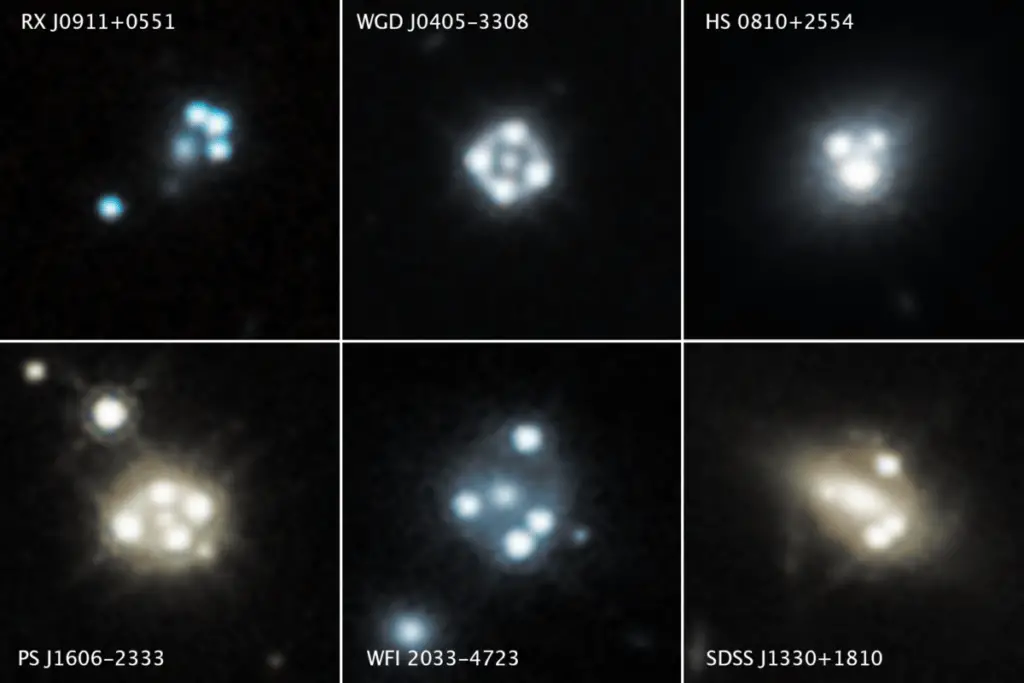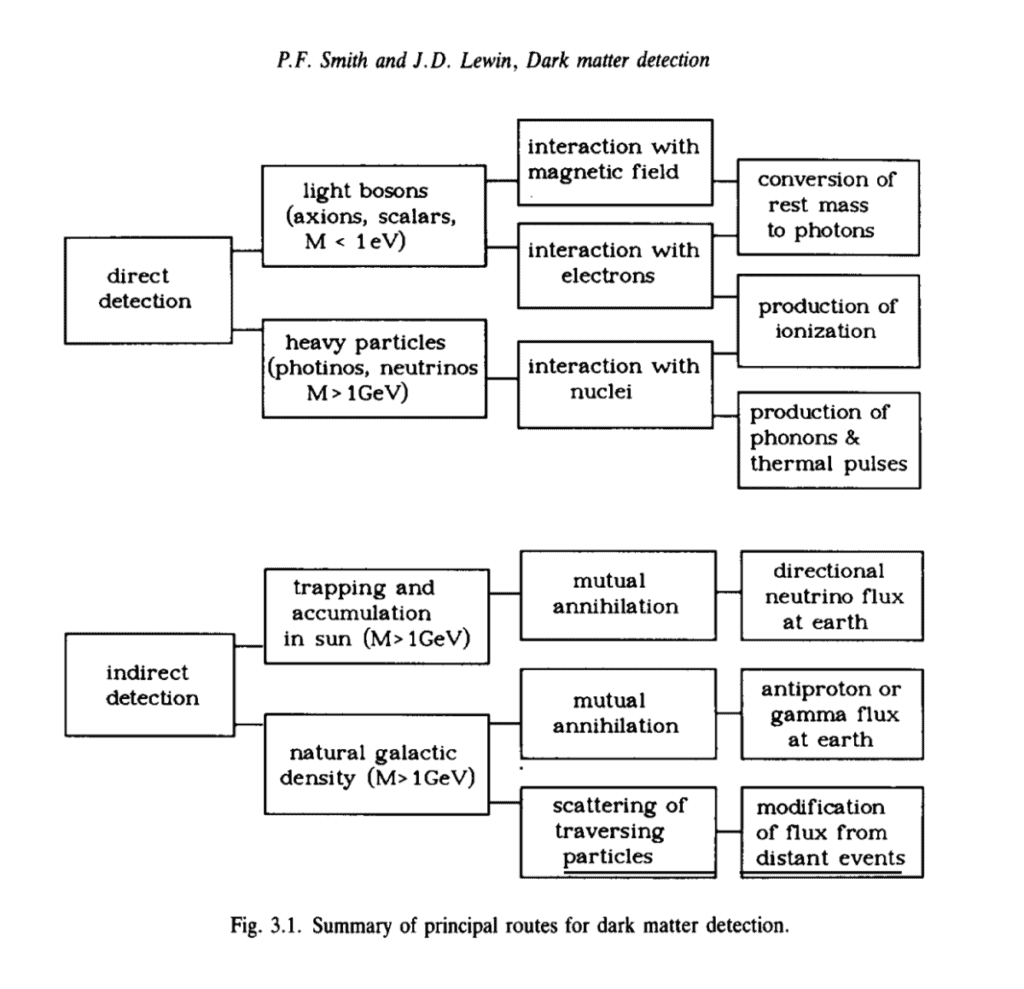When we look out through a telescope into our known and observable universe, we can see the stars that make up the constellations of our night sky, the distant galaxies, and nebulas that have shone brightly since their formation. But, there is also a lot of darkness… Does nothing really exist in this dark abyss?
Not necessarily.
Evidence has been proposed for the existence of dark matter as the gravity of the normal matter is not strong enough to cause the formation of complex structures (i.e., galaxies). There must be something else in the universe that keeps the stars together; something that cannot be detected normally as it does not interact with electromagnetic forces, which means it does not absorb, reflect or emit electromagnetic radiation (ex. Visible light).
Given that dark matter is so difficult to detect, what do we actually know about it?
What is Dark Matter?

A theoretical model for the composition of the universe has been proposed by scientists to be ~68% dark energy, ~27% dark matter, and ~5% normal matter (NASA).
If you are wondering about dark energy, I promise I will get to it another day. For now, let’s see if we can figure out what the heck dark matter really is.
What Dark Matter Is Not
If you’ve done your research already, I’m sure you are a lot more certain of what dark matter is not than what it really is.
Dark matter is not just dark clouds of normal matter without stars, because then we would be able to detect the baryon particles that make up these clouds through their absorption of radiation.
Dark matter is not anti-matter because anti-matter produces unique gamma-ray signals when it reacts with normal matter.
Finally, dark matter is not made up of galaxy-sized black holes. Although they do also bend light passing near them from objects far away, we have not observed enough lensing events to suggest that black holes make up the required 27% dark matter contribution to the universe (NASA).
Despite our limited amount of information, scientists have suggested a few possibilities on what dark matter could be.
MACHOs
It’s not time to rule out baryonic particles just yet. “Baryonic matter could still make up dark matter if it were tied up in brown dwarfs or small dense chunks of heavy elements” known as Massive Astrophysical Compact Halo Objects, or “MACHOs” (NASA).
On a good day, everything in our life can be referred to as baryonic matter as baryonic particles provide these objects with the property of mass. And this of course includes the MACHOs.
Current candidates for MACHOs that we commonly know of include black holes, neutron stars and brown dwarfs. These astronomical bodies are not luminous, but with gravitational lensing we can observe their gravity bending light as they pass in front of a star.
Research groups including the MACHO Collaboration Experiment at MIT and the EROS2 Collaboration have published papers with differing conclusions regarding the amount of microlensing observed in our galaxy. However, later searches with the Hubble Space Telescope’s NICMOS instrument showed a negligible fraction of dark matter as part of the halo mass, which led to the conclusion that the missing mass problem (dark matter) cannot be solved by MACHOs.
WIMPs
MACHOs aside, the most common view for what makes up dark matter is actually more exotic particles like Weakly Interacting Massive Particles (WIMPs).
Although the name says ‘weakly’, WIMPs are under no circumstances an easy target for bullying. WIMPs are “weak” because they only interact through the weak nuclear force and gravity.
These hypothetical particles could have been produced thermally in the early universe through particle collisions at a temperature greater than the mass of the particle, but as the temperature decreases with time, so does their density.
What does this mean?
Well, during the early universe, the WIMPs were abundant and were rapidly converting to lighter particles and vice versa. But as the universe expanded, the temperature dropped accordingly below the mass of the particle, causing the rate for the formation of the WIMPs to drop below the universe’s expansion rate (3).
This would have resulted in an exponential decrease in the number of WIMP particles as the drop in temperature did not affect their self-annihilation process. In the end, the density of WIMPs fell out of equilibrium and remained a theoretical relic of the past (3).
If this model were later proved to be true, then dark matter particles would indeed exert the same properties as WIMPs.
Does Dark Matter actually exist?
The simple answer I have is… YES! Research for the past 4 decades has given us many insights into the theoretical existence of dark matter.

Image by NASA, ESA, A. Nierenberg (JPL) and T. Treu (UCLA)
The presence of the dark matter component in our universe was inferred from observations of the rotational velocity of stars and gas in our galaxy (1,2):
- The high rotation speed of gas and stars in the outer parts of spiral galaxies
- The high-velocity dispersion and extended X-ray halo of hot gas in elliptical galaxies
- The high-velocity dispersion and gas temperature in clusters of galaxies
The observation for the rotational velocity enables us to calculate the mean density of matter as a function of distance from a galactic center (2).
Thus, the contribution of dark matter within a galaxy is usually specified in terms of their mass-to-light ratio (M/L) (1). This means the higher the ratio, the more dark matter there is to exist within a specific region of space. Even if dark matter does not absorb, reflect, or emit light, it will still contribute to the total density (mass in a given volume of space).
It has been well known on average that the M/L ratio increases from the bright luminous part of the galaxy to their faint halos, which actually comprises about 90% of the total mass of the galaxy (2). Systems on a much larger scale such as groups and galaxy superclusters experience an even greater increase as we approach their outer halos (1).
How can we detect Dark Matter?
The detection methods for dark matter particles might be a little hard to comprehend as it doesn’t conform to our common understanding of what makes up matter.
If I show you an apple and ask you for its composition, what might your answer be?
You could tell me it’s made of minerals, water, fructose, etc., and you know what… you would be correct! But what if I asked you to go deeper?
Well, something as simple as a water molecule is made up of two hydrogen atoms and one oxygen atom, and a single oxygen atom contains a positively charged nucleus and six electrons in its outer shell; the nucleus is made of protons and neutrons which are in turn made of quarks… and so on. You get my point.
All the normal matter that we see and know is made up of millions of tiny particles that contain energy. Although we can’t see it, there are no reasons to suggest the same does not apply to dark matter.
So, in our search for dark matter particles, we have a general direction, but not a firm idea on what to look for or what we might find. Dark matter could be made of known particles, or it might be made of something completely new… or a little bit of both!
Based on this, scientists turn to detection methods for energy signals that seem out of place or have unique interactions with known particles.

Image by NASA
Particles are usually detected based on their transfer of energy to electrons within a detecting apparatus, but the difficulty in detecting hypothetical dark matter particles is that the possible candidates are neutral, low energy, and weakly interacting (2).
While charged particles and photons can be detected directly, neutral particles require a little more work.
In general, neutral particles rely on utilizing an interaction or sequence of interactions to produce a charged particle, which can then be detected by its conversion to an electron or by its transfer of energy to electrons (2).
Two main routes have been proposed for producing this detectable effect from possible dark matter particles. These two routes have been classified into direct and indirect methods.
Direct methods are those that analyze the reactions taking place in the terrestrial apparatus, which is a fancy way of saying ‘on Earth’, while indirect methods involve interactions that might occur outside the earth, which could suggest new observable particles (2).

Indirect Methods of Detecting Dark Matter Particles
In the case for indirect detection, we have been given candidates (Fig. 3.1) for dark matter particles that might be trapped and accumulated in the sun, whose presence could be detected if they collided with their anti-particle (self-annihilation) to produce a flux of neutrinos that can be observed from underground detectors on Earth (2).
Another candidate proposed is naturally occurring halo particles, whose self-annihilation could produce significant fluxes of antiprotons, positrons, or gamma rays for us to detect on Earth. Otherwise, we might detect disruption from the incoming flow of particles of distant events, such as the dispersion or modification of a burst of neutrinos from a supernova (2).
Direct Methods of Detecting Dark Matter Particles
When we refer to direct detection methods, the focus is turned to two types of particles: heavy particles and light bosons (Fig. 3.1).
The heavy particles are generally in reference to photinos, which is a hypothetical elementary subatomic particle that acts like the fermion partner to a photon, as well as (heavy) neutrinos with a mass greater than 1 GeV (billion electron volts).
*Energy and mass of subatomic particles are generally measured in electron volts.
Detection for the heavy neutrinos become possible if an accelerated collision were to occur with another particle or a material target, which can be observed through the production of phonons – a unit of vibrational energy within an atom that can either be detected directly, as small temperature pulses, or as smaller fractions of energy converted to ionization (2).
This process would actually be easy to observe if the heavy neutrino was the only particle we were looking for, but we cannot build heavy particle detectors on this basis alone as there are other candidates available. Or more specifically the photino, whose interaction as an elementary particle (the building block of (dark) matter) with other particles may predominantly be spin dependant and not release energy that is distinguishable from the cosmic background (2).
The second type of particles that could be detected via direct detection methods is light bosons, an elementary particle with a full integer spin as compared to a photino’s (fermion particle) half-odd integer spin.
The light bosons can be classified as axion and scalar (particle with no spin) particles, as well as particles with a mass less than 1 eV.
The light axion particles are inherently harder to detect as it has difficulties keeping bonded with matter due to its low coupling constant. This means a lower chance of reactions occurring which makes it harder to observe any events that hint towards its existence.
This however could be overcome if we were able to convert an axion into a photon through a magnetic field within a vacuum. The resulting photon would have energy equal to the axion mass, which can be detected within a very narrow frequency band of the microwave/infrared region (2). As a photon, the light axions can also be detected through the observation for single ionization pulses due to the photoelectric effect (the release of electrically charged particles when a material absorbs EMR) from material targets (ex. solar panels!).
Similar methods of detection also work for the scalar particle, which without a spin makes it easier to design experiments that provide higher probabilities for reactions to occur and observe (2).
Why is Dark Matter Important?
Modern humans have been inhabiting the Earth and prospering while doing so with no prior knowledge of dark matter for the past 200,000 years. If we are getting by just fine, why have some of us dedicated our entire life trying to find something we can’t even see?
Unfortunately, there is no deep existentialist view on why we are on a search for invisible matter.
Some have proposed the possibility of utilizing dark matter as fuel for an interstellar engine, as dark matter can always be found simply by traveling across the universe.
Others hope that the understanding of dark matter could help humans understand the formation and evolution of galaxies, as well as the size, shape, and future of the universe. The amount of dark matter will help us determine whether the universe will continue to expand, expand to a point then collapse on itself, or expand until it reaches an equilibrium (NASA).
The answer might not be what we like, and the answer will probably not affect us within our lifetime. But we have to start somewhere.
References
- Neta A. Bahcall et al 1995 ApJ 447 L81
- Smith, P. F., & Lewin, J. D. (1990). Dark matter detection. Physics Reports, 187(5), 203–280. https://doi.org/10.1016/0370-1573(90)90081-c
- arXiv:hep-ph/9710467v1
